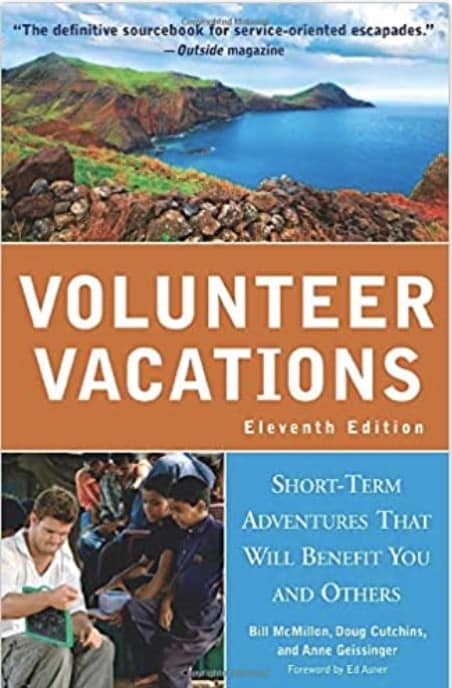By Bill McMillon, Doug Cutchins, and Anne Geissinger
“Voluntourism” is sometimes labeled as a “new” and even “unorthodox” way to travel. I myself have described such vacations in similar terms. Superficial impressions aside, voluntourism—like alternative travel more generally—has become accessible to a much wider base of travelers than was previously the case.
vacations in similar terms. Superficial impressions aside, voluntourism—like alternative travel more generally—has become accessible to a much wider base of travelers than was previously the case.
With a sturdy foundation of literature and online resources and an array of organizations to choose from, the daring-trailblazer mentality isn’t necessarily prerequisite for those who wish to pair travel with volunteering. As a testament to this fact, Volunteer Vacations is in its tenth edition.
The authors are very up-front about their book: they say that Volunteer Vacations isn’t a review book; it is a resource guide. The book presents a catalog of organization and provides a categorical description for each. A clever indexing system astutely divides organizations according to project length, project location, project season, project type, disability-friendly organizations, family-friendly organizations, and senior-friendly organizations.
This format reflects the construction of the book in broader terms: it is explicitly tuned to matching the needs and desires of prospective travelers with the organizations and projects which will suit them best. Organizations themselves are broken down and described according to a framework that is listed in the introductory section.
Along with these pragmatically minded categories, Volunteer Vacations offers reflective vignettes written by former volunteers on some (but not nearly all) of the various organizations listed and their personal experience.
Of Puja and Pappadams: Teaching English in South India
By Erica Garrecht-Williams
Volunteering Organization: Travelers Worldwide

In the winter of my gap year, I left the familiarity of home to teach English in India with Travelers Worldwide. With only a backpack on my back and hope in my heart that someone would actually be waiting there to greet me, I boarded a Chennai-bound airplane alone. I can’t remember ever feeling smaller or more alone then I did then, at JFK airport walking away from my parents into the January night, into the great unknown.
I had no idea what to expect when I landed in Madurai. Even now, India remains the only place I have ever experienced genuine culture shock. The trip to the hotel was unforgettable—the traffic of rickshaws, bicycles, and ox carts competing vehemently for a piece of the road, the silky bright pinks and yellows of women’s saris hanging languidly off their caramel shoulders…
The sight of beggar children in doorways, the cows munching garbage piles on the side of the road, the smell of samosas frying in oil, of fresh pineapple, curries, and jasmine, of trash and red earth baking in the noonday sun—all flew past my open window, overwhelming my senses.
I remember spending the first few days mainly in my hotel room, protected from the realities of where I was. But slowly, surely, I came out more and confronted my discomfort. Sooner than I ever thought, I got comfortable, and realized it was just living, getting up in the morning, eating, teaching, breathing, like anywhere else.
My friends and I slowly discovered our way around, visited the temples, found where to buy the best mango juice in town, learned to navigate the best stalls at the labyrinthine market, and fell into routines. It was wonderful and novel to make Madurai in my home, to really learn and appreciate its daily rhythms, from the 5 A.M. wailings of the mosque call to prayer to the cool respite of a quiet evening, full of neon light and stars.
Street Kids’ Community Villages
Teaching 8th Grade English
My placement was teaching at the YWCA Matriculation Higher Secondary School. I taught an eighth standard English class (twelve-to thirteen-year-olds) and with another volunteer taught several music classes that consisted mostly of learning and practicing English songs like “Head-Shoulders-Knees-and-Toes” and the “Hokey Pokey.”
Teaching English was a more challenging, but more rewarding experience. I remember feeling very frustrated, especially by trying to negotiate a medium, a common ground, between two very different cultures and two very different educational systems. My students were very bright, but they hadn’t been taught to think, rather to copy and memorize.
They had trouble asking questions or admitting they didn’t understand. It really made me think about and appreciate the privileges of my own education. But it was also exciting to see their progress, to see them learning to be a little more creative and engaged with English, and to see that I had had a part in that.
Starting to untangle India brought me closer than I ever would have expected to my fellow volunteers, as we all grappled with it together. It was strange and interesting to really understand how Indians saw us Westerners, to feel like celebrities everywhere we went (I once got asked for my autograph at school!), to try to look at our own culture from the outside, for better or worse.
And to learn about Indian people: their beautiful culture, the way they see religion as integral to daily life, their infinite generosity and patience, the challenges many of them face. It was so mind-blowing to see a way of life that is so ancient and that still hasn’t been bought out by homogeneous Western Culture, to see how possible it is to live a life less wastefully and more fully than we do.
I came home changed in more ways than I could’ve hoped for, more conscious of who I was, my priorities, my responsibilities as a privileged American, and more aware of the unbelievable beauty and terrible disparity that exists in the world. Four years later, none of those lessons have faded, and I can still smell the jasmine in the air.

Each listing in this book contains up to twelve sections:
- General contact information: including (as available) postal address, phone and fax numbers, e-mail addresses, and Web site URLs.
- Project Type: We asked each organization to place itself into one of approximately twenty-five categories, so that you can tell at a glance what an organization does, broadly speaking. You can use this section (in addition to the indexes) if you are glancing casually through the book for, say, opportunities to volunteer with orphans, or another specific type of opportunity.
- Mission Statement Excerpt: This statement gives you an idea of how each Organization defines itself.
- Year Founded and Number of Volunteers Last Year: Though numbers can certainly be misleading, you can get a sense of the scope of an organization’s work by looking at how long it has been in existence and how many people they are used to serving. That said, don’t reject small or recently founded organizations out of hand; some of our favorite organizations are young, but they have passionate, go-getter administrators behind them.
- Funding Sources: To borrow the old dictum from the movie All the President’s Men, “Follow the money.” This step is important, as knowing where an organization’s funding comes from helps you know more about its reason for being and who supports its work. Luckily, most organizations are very up-front about this information; they don’t want disaffected volunteers who don’t share their mission.
- Assume that the funding sources that are listed here are in addition to the program fees that organizations charge to volunteer with them.
- The Work They Do: Here’s where we get into the meat of the description. This part describes in broad terms what the work of the organization is, as well as how volunteers help with that work. Look for specifics on volunteer jobs and examples of how you’ll be spending your time with this organization.
- Project Location: The location can be incredibly specific for some of our smaller organizations, or “worldwide” for organizations that operate a large number of ever-changing global operations. Also included in this section are details, as we know them, about lodging accommodations so that you can be sure you’ll be comfortable with the arrangements.
- Time Line: Information here includes when applications are accepted, when volunteer positions begin, and how long positions last (minimum, maximum, and average time lengths).
- Cost: Yes, virtually all of these opportunities cost money (the few that do not usually require very specialized skills or a long-term commitment). This section tries to detail as best as it can what those costs will be, as well as what is included in the organizations’ fees and what additional expenses you will need to bear. Pay close attention to insurance coverage; if the organization does not provide insurance, check with your insurance provider before departure to make sure that you will be covered overseas. If not, please consider purchasing a short term supplemental policy.
- Getting Started: This section gives information about how to best contact the organization or obtain an application, whether or not an interview is required, as well as details on training and orientation programs.
- Needed Skills and Specific Populations: If an organization requires that you have mastered specific skills before volunteering with them, that information will be noted here. Also found here is information regarding age minimums and maximums, as well as information for volunteers with disabilities and families.
Buy this Book from Volunteer Vacations: Short-Term Adventures That Will Benefit You and Others
- Missouri Sports Travel Adventure: From Landmarks to Ballparks - January 21, 2026
- What First-Time Visitors Get Wrong About Visiting Iceland - January 15, 2026
- Bareboat Charter vs all-inclusive Crewed: Which Luxury Charter Fits You? - December 29, 2025




